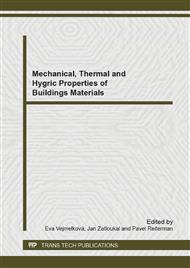p.94
p.100
p.104
p.108
p.114
p.119
p.125
p.130
p.136
Residual Strength of Thermally Loaded Mortars with Treated Municipal Solid Waste Incineration Fly Ash Used as Supplementary Cementitious Material
Abstract:
Fly ashes collected in Air Pollution Control lines of Municipal Solid Waste Incinerators (MSWI) differ highly from fly ashes generated during coal burning what complicates their utilization in building materials production. Nevertheless after a treatment such ashes can have properties relatively comparable with coal fly ashes and thus can be used as Supplementary Cementitious Material (SCM). The water extracted MSWI fly ash was used as partial Portland cement replacement in mortars. The mortars strength evolution in time was monitored; behavior typical for pozzolans – slower increase of strength – was observed. Influence of thermal load on strength of mortars was studied as well. It can be concluded that water extracted MSWI fly ash can be used as 10 % Portland cement substitute without loss of mechanical properties.
Info:
Periodical:
Pages:
114-118
Citation:
Online since:
July 2014
Authors:
Price:
Сopyright:
© 2014 Trans Tech Publications Ltd. All Rights Reserved
Share:
Citation:


